Can We Unambiguously Define the Dipole Moment of Molecules in the Condensed Phase?
Abstract
1. Introduction
2. Results and Discussion
2.1. Mono-Alcohols
2.2. Aprotic Molecule with High Dipole Moment
2.2.1. Acetonitrile
2.2.2. Pyridine
2.2.3. Acetone
2.3. Chemical Energy Component Analysis (CECA)
3. Methods
4. Conclusions
Supplementary Materials
Author Contributions
Funding
Institutional Review Board Statement
Informed Consent Statement
Data Availability Statement
Conflicts of Interest
References
- Hickey, A.L.; Rowley, C.N. Benchmarking Quantum Chemical Methods for the Calculation of Molecular Dipole Moments and Polarizabilities. J. Phys. Chem. A 2014, 118, 3678–3687. [Google Scholar] [CrossRef] [PubMed]
- Leverentz, H.R.; Maerzke, K.A.; Keasler, S.J.; Siepmann, J.I.; Truhlar, D.G. Electrostatically embedded many-body method for dipole moments, partial atomic charges, and charge transfer. Phys. Chem. Chem. Phys. 2012, 14, 7669–7678. [Google Scholar] [CrossRef] [PubMed]
- Hait, D.; Head-Gordon, M. How accurate is density functional theory at predicting dipole moments? An assessment using a new database of 200 benchmark values. J. Chem. Theory Comput. 2018, 14, 1969–1981. [Google Scholar] [CrossRef]
- Grotjahn, R.; Lauter, G.J.; Haasler, M.; Kaupp, M. Evaluation of Local Hybrid Functionals for Electric Properties: Dipole Moments and Static and Dynamic Polarizabilities. J. Phys. Chem. A 2020, 124, 8346–8358. [Google Scholar] [CrossRef] [PubMed]
- Jørgensen, M.W.; Faber, R.; Ligabue, A.; Sauer, S.P.A. Benchmarking Correlated Methods for Frequency-Dependent Polarizabilities: Aromatic Molecules with the CC3, CCSD, CC2, SOPPA, SOPPA(CC2), and SOPPA(CCSD) Methods. J. Chem. Theory Comput. 2020, 16, 3006–3018. [Google Scholar] [CrossRef]
- Verma, P.; Truhlar, D.G. Can Kohn–Sham density functional theory predict accurate charge distributions for both single-reference and multi-reference molecules? Phys. Chem. Chem. Phys. 2017, 19, 12898–12912. [Google Scholar] [CrossRef]
- Chołuj, M.; Kozłowska, J.; Bartkowiak, W. Benchmarking DFT methods on linear and nonlinear electric properties of spatially confined molecules. Int. J. Quantum Chem. 2018, 17, e25666. [Google Scholar] [CrossRef]
- Rivelino, R.; Costa Cabral, B.J.; Coutinho, K.; Canut, S. Molecular Polarization in Liquid Environment. In Trends and Perspectives in Modern Computational Science; Maroulis, G., Simos, T., Eds.; CRC Press, Taylor and Francis Group: Boca Raton, FL, USA, 2006; Volume 6, pp. 80–90. [Google Scholar]
- Georg, H.C.; Coutinho, K.; Canuto, S. Converged Electronic Polarization of Acetone in Liquid Water and the Role in the n–π* Transition. Chem. Phys. Lett. 2006, 429, 119–123. [Google Scholar] [CrossRef]
- Kiataki, M.B.; do N. Varella, M.T.; Coutinho, K. New approach to instantaneous polarizable electrostatic embedding of the solvent. J. Mol. Liq. 2023, 389, 122861. [Google Scholar] [CrossRef]
- Costa Cabral, B.J.; Coutinho, K.; Canut, S. Electronic polarization in liquid acetonitrile: A sequential Monte Carlo/quantum mechanics investigation. Chem. Phys. Lett. 2005, 407, 13–17. [Google Scholar] [CrossRef]
- Gomes Estacio, S.; Martiniano, H.F.M.C.; Cabral do Couto, P.; Costa Cabral, B.J. Electronic Properties of Hydrogen Bond Networks: Implications for Solvent Effects in Polar Liquids. In Solvation Effects on Molecules and Biomolecules. Challenges and Advances in Computational Chemistry and Physics; Canuto, S., Ed.; Springer: Dordrecht, The Netherlands, 2008; Volume 6, pp. 115–133. [Google Scholar] [CrossRef]
- Jorge, M.; Gomes, J.R.B.; Milne, A.W. Self-consistent electrostatic embedding for liquid phase polarization. J. Mol. Liq. 2021, 322, 114550. [Google Scholar] [CrossRef]
- Kemp, D.D.; Mark, S.; Gordon, M.S. An Interpretation of the Enhancement of the Water Dipole Moment Due to the Presence of Other Water Molecules. J. Phys. Chem. A 2008, 112, 4885–4894. [Google Scholar] [CrossRef] [PubMed]
- Cardamone, S.; Hughes, T.J.; Popelier, P.L.A. Multipolar electrostatics. Phys. Chem. Chem. Phys. 2014, 16, 10367. [Google Scholar] [CrossRef]
- Jorge, M.; Gomes, J.R.B.; Barrera, M.C. The dipole moment of alcohols in the liquid phase and in solution. J. Mol. Liq. 2022, 356, 119033. [Google Scholar] [CrossRef]
- Jorge, M.; Barrera, M.C.; Milne, A.W.; Ringrose, C.; Cole, D.J. What is the Optimal Dipole Moment for Nonpolarizable Models of Liquids? J. Chem. Theory Comput. 2023, 19, 1790–1804. [Google Scholar] [CrossRef]
- Millot, C.; Costa Cabral, B.J. Electronic Properties of Liquid Water by Sequential Molecular Dynamics/Density Functional Theory. Chem. Phys. Lett. 2008, 460, 466–469. [Google Scholar] [CrossRef]
- Kongsted, J.; Osted, A.; Mikkelsen, K.V.; Christiansen, O. Dipole and Quadrupole Moments of Liquid Water Calculated Within the Coupled Cluster/Molecular Mechanics. Chem. Phys. Lett. 2002, 364, 379–386. [Google Scholar] [CrossRef]
- Osted, A.; Kongsted, J.; Mikkelsen, K.V.; Åstrand, P.-O.; Christiansen, O. Statistical mechanically averaged molecular properties of liquid water calculated using the combined coupled cluster/molecular dynamics method. J. Chem. Phys. 2006, 124, 124503. [Google Scholar] [CrossRef]
- Delle Site, L.; Alavi, A.; Lynden-Bell, R.M. The electrostatic properties of water molecules in condensed phases: An ab initio study. Mol. Phys. 1999, 96, 1683–1693. [Google Scholar] [CrossRef]
- Bakó, I.; Mayer, I. Hierarchy of the Collective Effects in Water Clusters. J. Phys. Chem. A 2016, 20, 4408–4417. [Google Scholar] [CrossRef]
- Bakó, I.; Mayer, I. On Dipole Moments and Hydrogen Bond Identification in Water Clusters. J. Phys. Chem. A 2016, 120, 4408–4417. [Google Scholar] [CrossRef]
- Bakó, I.; Daru, J.; Pothoczki, S.; Pusztai, L.; Hermansson, K. Effects of H-bond asymmetry on the electronic properties of liquid water—An AIMD analysis. J. Mol. Liq. 2019, 293, 111579. [Google Scholar] [CrossRef]
- Bakó, I.; Csókás, D.; Mayer, I.; Pothoczki, S.; Pusztai, L. The influence of cations on the dipole moments of neighboring polar molecules. Int. J. Quantum Chem. 2022, 122, e26758. [Google Scholar] [CrossRef]
- Bader, F.W.; Matta, C.F. Properties of Atoms in Crystals: Dielectric Polarization. Int. J. Quantum Chem. 2001, 85, 592–607. [Google Scholar] [CrossRef]
- Groß, L.; Herrmann, C. GenLocDip: A Program to Calculate and Visualize Local Electric Dipole Moments. J. Comp. Chem. 2016, 37, 2324–2334. [Google Scholar] [CrossRef]
- Badyal, Y.S.; Saboungi, M.-L.; Price, D.L.; Shastri, S.D.; Haeffner, D.R.; Soper, A.K. Electron Distribution in Water. J. Chem. Phys. 2000, 112, 9206–9208. [Google Scholar] [CrossRef]
- Gubskaya, A.V.; Kusalik, P.G. The Total Molecular Dipole Moment for Liquid Water. J. Chem. Phys. 2002, 117, 5290–5302. [Google Scholar] [CrossRef]
- Silvestrelli, P.L.; Parrinello, M. Water Dipole Moment in the Gas and Liquid Phase. Phys. Rev. Lett. 1999, 82, 3308–3311. [Google Scholar] [CrossRef]
- Lipparini, F.; Mennucci, B. Perspective: Polarizable continuum models for quantum-mechanical descriptions. J. Chem. Phys. 2016, 144, 160901. [Google Scholar] [CrossRef]
- Herbert, J.M. Dielectric continuum methods for quantum chemistry. WIREs Comput. Mol Sci. 2021, 11, e1519. [Google Scholar] [CrossRef]
- Vassetti, D.; Oğuz, I.C.; Labat, F. Generalizing Continuum Solvation in Crystal to Nonaqueous Solvents: Implementation, Parametrization, and Application to Molecules and Surfaces. J. Chem. Theory Comput. 2021, 17, 6432–6448. [Google Scholar] [CrossRef] [PubMed]
- Marenich, A.V.; Cramer, C.J.; Truhlar, D.G. Universal Solvation Model Based on Solute Electron Density and on a Continuum Model of the Solvent Defined by the Bulk Dielectric Constant and Atomic Surface Tensions. J. Phys. Chem. B 2009, 113, 6378–6396. [Google Scholar] [CrossRef] [PubMed]
- Cancès, E.; Mennucci, B.; Tomasi, J. A New Integral Equation Formalism for the Polarizable Continuum Model: Theoretical Background and Applications to Isotropic and Anisotropic Dielectrics. J. Chem. Phys. 1997, 107, 3032–3041. [Google Scholar] [CrossRef]
- Miertuš, S.; Scrocco, E.; Tomasi, J. Electrostatic Interaction of a Solute with a Continuum. A Direct Utilization of AB Initio Molecular Potentials for the Prevision of Solvent Effects. Chem. Phys. 1981, 55, 117–129. [Google Scholar] [CrossRef]
- Miertus, S.; Tomasi, J. Approximate Evaluations of the Electrostatic Free Energy and Internal Energy Changes in Solution Processes. Chem. Phys. 1982, 65, 239–245. [Google Scholar] [CrossRef]
- Boys, S.F. Construction of Some Molecular Orbitals to Be Approximately Invariant for Changes from One Molecule to Another. Rev. Mod. Phys. 1960, 32, 296. [Google Scholar] [CrossRef]
- Kohn, W. Analytic properties of Bloch waves and Wannier functions. Phys. Rev. 1959, 115, 809–821. [Google Scholar] [CrossRef]
- Pipek, J.; Mezey, P.G. Dependence of MO shapes on a continuous measure of delocalization. Int. J. Quantum Chem. 1988, 34, 1. [Google Scholar] [CrossRef]
- Pipek, J.; Mezey, P.G. A fast intrinsic localization procedure applicable for ab initio and semiempirical linear combination of atomic orbital wave functions. J. Chem. Phys. 1989, 90, 4916. [Google Scholar] [CrossRef]
- Mayer, I. Non-orthogonal Localized Orbitals and Orthogonal Atomic Hybrids Derived from Mulliken’s Population Analysis. Chem. Phys. Lett. 1995, 242, 499–506. [Google Scholar] [CrossRef]
- Magnasco, V.; Perico, A. Uniform Localization of Atomic and Molecular Orbitals. I. J. Chem. Phys. 1967, 47, 971–981. [Google Scholar] [CrossRef]
- Mayer, I. Effective Atomic Orbitals: A Tool for Understanding Electronic Structure of Molecules. Int. J. Quantum Chem. 2014, 114, 1041–1047. [Google Scholar] [CrossRef]
- Mayer, I. Orthogonal effective atomic orbitals in the topological theory of atoms. Can. J. Chem. 1996, 74, 939–942. [Google Scholar] [CrossRef]
- Ben Amor, N.; Evangelisti, S.; Leininger, T.; Andrae, D. Local Orbitals in Quantum Chemistry. In Basis Sets in Computational Chemistry; Perlt, E., Ed.; Springer International Publishing: Berlin/Heidelberg, Germany, 2021; Volume 107, pp. 41–101. [Google Scholar] [CrossRef]
- Nikolaienko, T.Y.; Bulavin, L.A. Localized orbitals for optimal decomposition of molecular properties. Int. J. Quantum Chem. 2019, 119, e25798. [Google Scholar] [CrossRef]
- Coulson, C.A.; Eisenberg, D. Interactions of H2O Molecules in Ice. II. Interaction Energies of H2O Molecules in Ice. Proc. R. Soc. London Ser. A 1966, A291, 454–459. [Google Scholar] [CrossRef]
- Brookes, D.H.; Head-Gordon, T. Family of Oxygen-Oxygen Radial Distribution Functions for Water. J. Phys. Chem. Lett. 2015, 6, 2938–2943. [Google Scholar] [CrossRef] [PubMed]
- Clough, S.A.; Beers, Y.; Klein, G.P.; Rothman, L.S. Dipole Moment of Water from Stark Measurements of H2O, HDO, and D2O. J. Chem. Phys. 1973, 59, 2254–2259. [Google Scholar] [CrossRef]
- McGrath, M.J.; Kuob, I.-F.W.; Siepmann, J.I. Liquid structures of water, methanol, and hydrogen fluoride at ambient conditions from first principles molecular dynamics simulations with a dispersion corrected density functional. Phys. Chem. Chem. Phys. 2011, 13, 19943–19950. [Google Scholar] [CrossRef]
- Handgraaf, J.-W.; van Erp, T.S.; Meijer, E.J. Ab initio molecular dynamics study of liquid methanol. Chem. Phys. Lett. 2003, 367, 617. [Google Scholar] [CrossRef]
- Handgraaf, J.-W.; Meijer, E.J.; Gaigeot, M.-P. Density-functional theory-based molecular simulation study of liquid methanol. J. Chem. Phys. 2004, 121, 10111. [Google Scholar] [CrossRef]
- Wang, C.C.; Tan, J.Y.; Liu, L.H. Ab initio molecular dynamics study of temperature and pressure-dependent infrared dielectric functions of liquid methanol. AIP Adv. 2017, 7, 035115. [Google Scholar] [CrossRef]
- Pagliai, M.; Cardini, G.; Righini, R.; Schettino, V. Hydrogen bond dynamics in liquid methanol. J. Chem. Phys. 2003, 119, 6655. [Google Scholar] [CrossRef]
- Amano, T.; Yamazaki, T.; Tsuneyuki, S. Chemical bond based machine learning model for dipole moment: Application to dielectric properties of liquid methanol and ethanol. Phys. Rev. B 2024, 110, 165159. [Google Scholar] [CrossRef]
- Blach, S.; Forbert, H.; Marx, D. On the Complex Hydrogen-Bond Network Structural Dynamics of Liquid Methanol: Chains, Rings, Bifurcations and Lifetimes. J. Chem. Phys. 2025, 162, 074112. [Google Scholar] [CrossRef]
- Morrone, J.A.; Haslinger, K.E.; Tuckerman, M.E. Ab Initio Molecular Dynamics Simulation of the Structure and Proton Transport Dynamics of Methanol-Water Solutions. J. Phys. Chem. B 2006, 110, 3712–3720. [Google Scholar] [CrossRef]
- Cassone, G.; Trusso, S.; Sponer, J.; Saija, F. Electric Field and Temperature Effects on the Ab Initio Spectroscopy of Liquid Methanol. Appl. Sci. 2021, 11, 5457. [Google Scholar] [CrossRef]
- Dias, R.F.; da Costa, C.C.; Manhabosco, T.M.; de Oliveira, A.B.; Matos, M.J.S.; Soares, J.S.; Batista, R.J.C. Ab initio molecular dynamics simulation of methanol and acetonitrile: The effect of van der Waals interactions. Chem. Phys. Lett. 2019, 714, 172–177. [Google Scholar] [CrossRef]
- Sieffert, N.; Bühl, M.; Gaigeot, M.-P.; Morrison, C.A. Liquid Methanol from DFT and DFT/MM Molecular Dynamics Simulations. J. Chem. Theory Comput. 2013, 9, 106–118. [Google Scholar] [CrossRef]
- Jorgensen, W.L.; Maxwell, D.S.; Tirado-Rives, J. Development and Testing of the OPLS All-Atom Force Field on Conformational Energetics and Properties of Organic Liquids. J. Am. Chem. Soc. 1996, 118, 11225–11236. [Google Scholar] [CrossRef]
- Vanommeslaeghe, K.; Hatcher, E.; Acharya, C.; Kundu, S.; Zhong, S.; Shim, J.; Darian, E.; Guvench, O.; Lopes, P.; Vorobyov, I.; et al. CHARMM General Force Field: A force field for drug-like molecules compatible with the CHARMM all-atom additive biological force fields. J. Comput. Chem. 2010, 31, 671–690. [Google Scholar] [CrossRef]
- Wang, J.; Wolf, R.M.; Caldwell, J.W.; Kollman, P.A.; Case, D.A. Development and testing of a general amber force field. J. Comput. Chem. 2004, 25, 1157–1174. [Google Scholar] [CrossRef] [PubMed]
- Anisimov, V.M.; Vorobyov, I.V.; Roux, B.; MacKerell, A.D. Polarizable empirical force field for the primary and secondary alcohol series based on the classical Drude model. J. Chem. Theory Comput. 2007, 3, 1927–1946. [Google Scholar] [CrossRef]
- Patel, S.; Brooks, C.L. A nonadditive methanol force field: Bulk liquid and liquid-vapor interfacial properties via molecular dynamics simulations using a fluctuating charge model. J. Chem. Phys. 2005, 122, 024508. [Google Scholar] [CrossRef]
- Yu, H.; Geerke, D.P.; Liu, H.; Van Gunstersen, W.F. Molecular Dynamics Simulations of Liquid Methanol and Methanol–Water Mixtures with Polarizable Model. J. Comput. Chem. 2006, 27, 1494–1504. [Google Scholar] [CrossRef] [PubMed]
- Podsiadlo, M.; Jakobek, K.; Katrusiak, A. Density, freezing and molecular aggregation in pyridazine, pyridine and benzene. Cryst. Eng. Comm. 2010, 12, 2561. [Google Scholar] [CrossRef]
- Crawford, S.; Kirchner, M.T.; Blaeser, D.; Boese, R.; David, W.I.F.; Dawson, A.; Gehrke, A.; Ibberson, R.M.; Marshall, W.G.; Parsons, S.; et al. Isotopic Polymorphism in Pyridine. Angew. Chem. Int. Ed. 2009, 48, 755–757. [Google Scholar] [CrossRef]
- Radnai, T.; Bakó, I.; Jedlovszky, P.; Pálinkás, G. Local order in some aprotic dipolar liquids. Mol. Sim. 1996, 16, 345. [Google Scholar] [CrossRef]
- Jedlovszky, P.; Pálinkás, G. Monte Carlo simulation of liquid acetone with a polarizable molecular model. Mol. Phys. 1995, 84, 217. [Google Scholar] [CrossRef]
- Nagasaka, M.; Yuzawa, H.; Kosugi, N. Intermolecular Interactions of Pyridine in Liquid Phase and Aqueous Solution Studied by Soft X-ray Absorption Spectroscopy. Z. Phys. Chem. 2018, 232, 705–722. [Google Scholar] [CrossRef]
- Mennucci, B.; da Silva, C.O. Quantum Mechanical Strategy to Investigate the Structure of Liquids: The Cases of Acetonitrile, Formamide, and Their Mixture. J. Phys. Chem. B 2008, 112, 6803–6813. [Google Scholar] [CrossRef]
- Bertagnolli, H.; Engelhardt, T.; Chieux, P. Study of Dipolar Interaction in Liquid Pyridine by X-Ray and Neutron Diffraction. Ber. Bunsenges. Phys. Chem. 1986, 90, 512. [Google Scholar] [CrossRef]
- Marcos, S. A general purpose acetonitrile interaction potential to describe its liquid, solid and gas phases. J. Mol. Liq. 2020, 318, 113975. [Google Scholar] [CrossRef]
- Myneni, H.; Jonsson, E.Ö.; Jonsson, H.; Dohn, A.O. Polarizable force field for acetonitrile based on the single-center multipole expansion. J. Phys. Chem. B 2022, 126, 9339–9348. [Google Scholar] [CrossRef] [PubMed]
- Baker, C.M. Polarizable force fields for molecular dynamics simulations of biomolecules. WIREs Comput. Mol. Sci. 2015, 5, 241–254. [Google Scholar] [CrossRef]
- Jing, Z.; Liu, C.; Cheng, S.Y.; Qi, R.; Walker, B.D.; Piquemal, J.-P.; Ren, P. Polarizable force fields for biomolecular simulations: Recent advances and applications. Annu. Rev. Biophys. 2019, 48, 371–394. [Google Scholar] [CrossRef]
- Zhang, C.; Bell, D.; Harger, M.; Ren, P. Polarizable Multipole-based Force Field for Aromatic Molecules and Nucleobases. J. Chem. Theory Comput. 2017, 13, 666–678. [Google Scholar] [CrossRef]
- Lopes, P.E.M.; Lamoureux, G.; MacKerell, A.D. Polarizable Empirical Force Field for Nitrogen-containing Heteroaromatic Compounds Based on the Classical Drude Oscillator. J. Comput. Chem. 2009, 30, 1821–1838. [Google Scholar] [CrossRef]
- Aina, A.A.; Misquitta, A.J.; Price, S.L. From dimers to the solid-state: Distributed intermolecular force-fields for pyridine. J. Chem. Phys. 2017, 147, 161722. [Google Scholar] [CrossRef]
- Ohba, T.; Ikawa, S. Far-infrared optical constants of liquid acetonitrile at 238 to 343 K as measured with a synchrotron radiation source. Mol. Phys. 1991, 73, 985. [Google Scholar] [CrossRef]
- Taylor, R.; Macrae, C.F. Rules governing the crystal packing of mono- and dialcohols. Acta Cryst. B 2001, 57, 815–827. [Google Scholar] [CrossRef]
- Zhao, Y.; Schultz, N.E.; Truhlar, D.G. Design of Density Functionals by Combining the Method of Constraint Satisfaction with Parametrization for Thermochemistry, Thermochemical Kinetics, and Noncovalent Interactions. J. Chem. Theory Comput. 2006, 2, 364–382. [Google Scholar] [CrossRef] [PubMed]
- Zhao, Y.; Truhlar, D.G. The M06 Suite of Density Functionals for Main Group Thermochemistry, Thermochemical Kinetics, Noncovalent Interactions, Excited States, and Transition Elements: Two New Functionals and Systematic Testing of Four M06-Class Functionals and 12 Other Function. Theor. Chem. Acc. 2008, 120, 215–241. [Google Scholar] [CrossRef]
- Chai, J.-D.; Head-Gordon, M. Long-Range Corrected Hybrid Density Functionals with Damped Atom-Atom Dispersion Corrections. Phys. Chem. Chem. Phys. 2008, 10, 6615–6620. [Google Scholar] [CrossRef]
- Torrie, B.H.; Weng, S.-X.; Powell, B.M. Structure of the α-phase of solid methanol. Mol. Phys. 1989, 67, 575–581. [Google Scholar] [CrossRef]
- Mayer, I. Improved chemical energy component analysis. Phys. Chem. Chem. Phys. 2012, 14, 337–344. [Google Scholar] [CrossRef] [PubMed]
- Barrow, M.J. α-Acetonitrile at 215 K. Acta Cryst. B 1981, 37, 2238–2242. [Google Scholar] [CrossRef]
- Frisch, M.J.; Trucks, G.W.; Schlegel, H.B.; Scuseria, G.E.; Robb, M.A.; Cheeseman, J.R.; Scalmani, G.; Barone, V.; Mennucci, B.; Petersson, G.A.; et al. Gaussian 09, Revision E.01; Gaussian, Inc.: Wallingford, CT, USA, 2009. [Google Scholar]
- Hamza, A.; Mayer, I. Physical analysis of the diatomic “chemical” energy components. Theor. Chem. Acc. 2003, 109, 91–98. [Google Scholar] [CrossRef]
- Mayer, I. A chemical energy component analysis. Chem. Phys. Lett. 2000, 332, 381. [Google Scholar] [CrossRef]
- Mayer, I.; Hamza, A. APOST, Version 1.0. 2000. Available online: http://occam.ttk.hu/programs (accessed on 18 March 2025).
- Mayer, I. Bond Order and Energy Components Extracting Chemical Information from Molecular Wave Function; CRC Press Taylor & Francis Group: Boca Raton, FL, USA, 2017. [Google Scholar]
- Vyboishchikov, S.F.; Krapp, A.; Frenking, G. Two complementary molecular energy decomposition schemes: The Mayer and Ziegler-Rauk methods in comparison. J. Chem. Phys. 2008, 129, 144111. [Google Scholar] [CrossRef]
- Bakó, I.; Jicsinszky, L.; Pothoczki, S. Systematic Study of Different Types of Interactions in α-, β- and γ-Cyclodextrin: Quantum Chemical Investigation. Molecules 2024, 29, 2205. [Google Scholar] [CrossRef]
- Johnsson, P.G. Hydrogen bond studies. CXIII. The crystal structure of ethanol at 87 K. Acta Cryst. B 1976, 32, 232–235. [Google Scholar] [CrossRef]
- Giordano, N.; Beavers, C.M.; Campbell, B.J.; Eigner, V.; Gregoryanz, E.; Marshall, W.G.; Pena-Alvarez, M.; Teat, S.J.; Vennari, C.E.; Parsons, S. High-pressure polymorphism in pyridine. IUCrJ 2020, 7, 58–70. [Google Scholar] [CrossRef] [PubMed]
- Huffman, J.C. (Department of Chemistry, State University of New York, Buffalo, NJ, USA). Private communication, 2001. COD Crytallography open database entry 5000049.

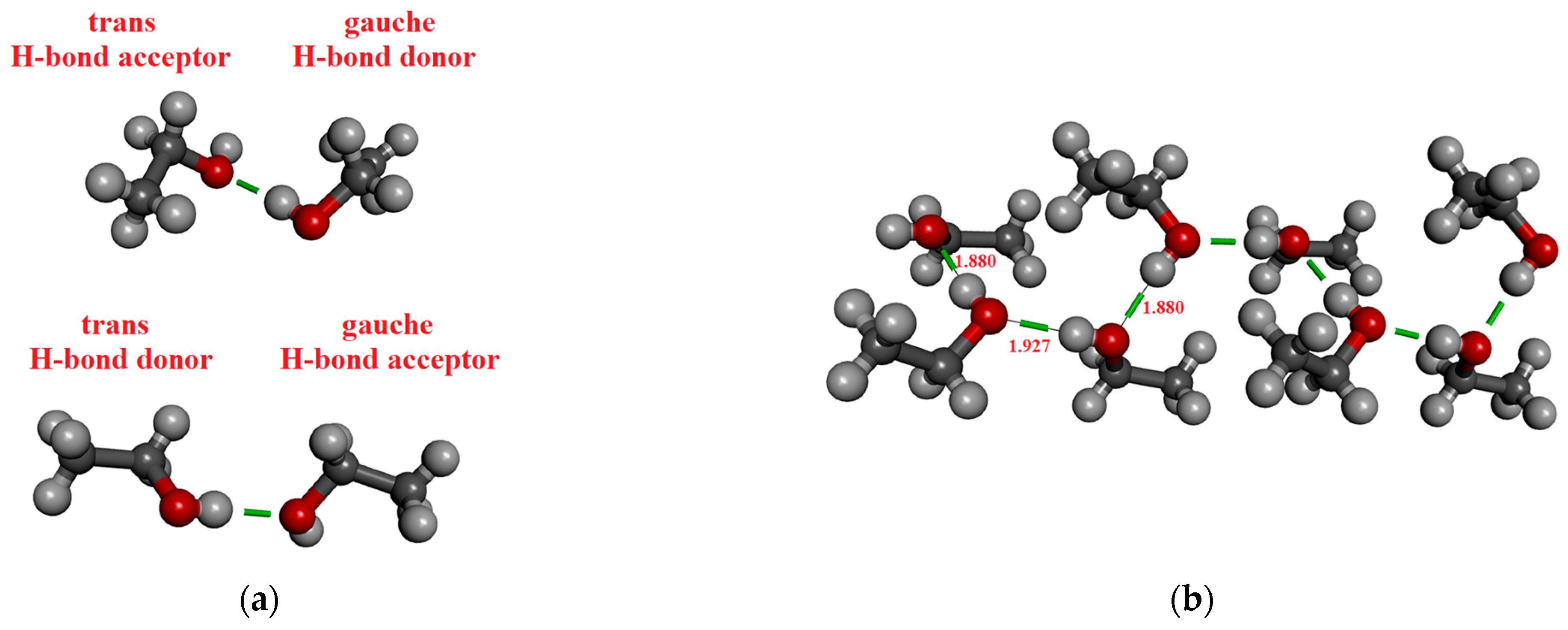
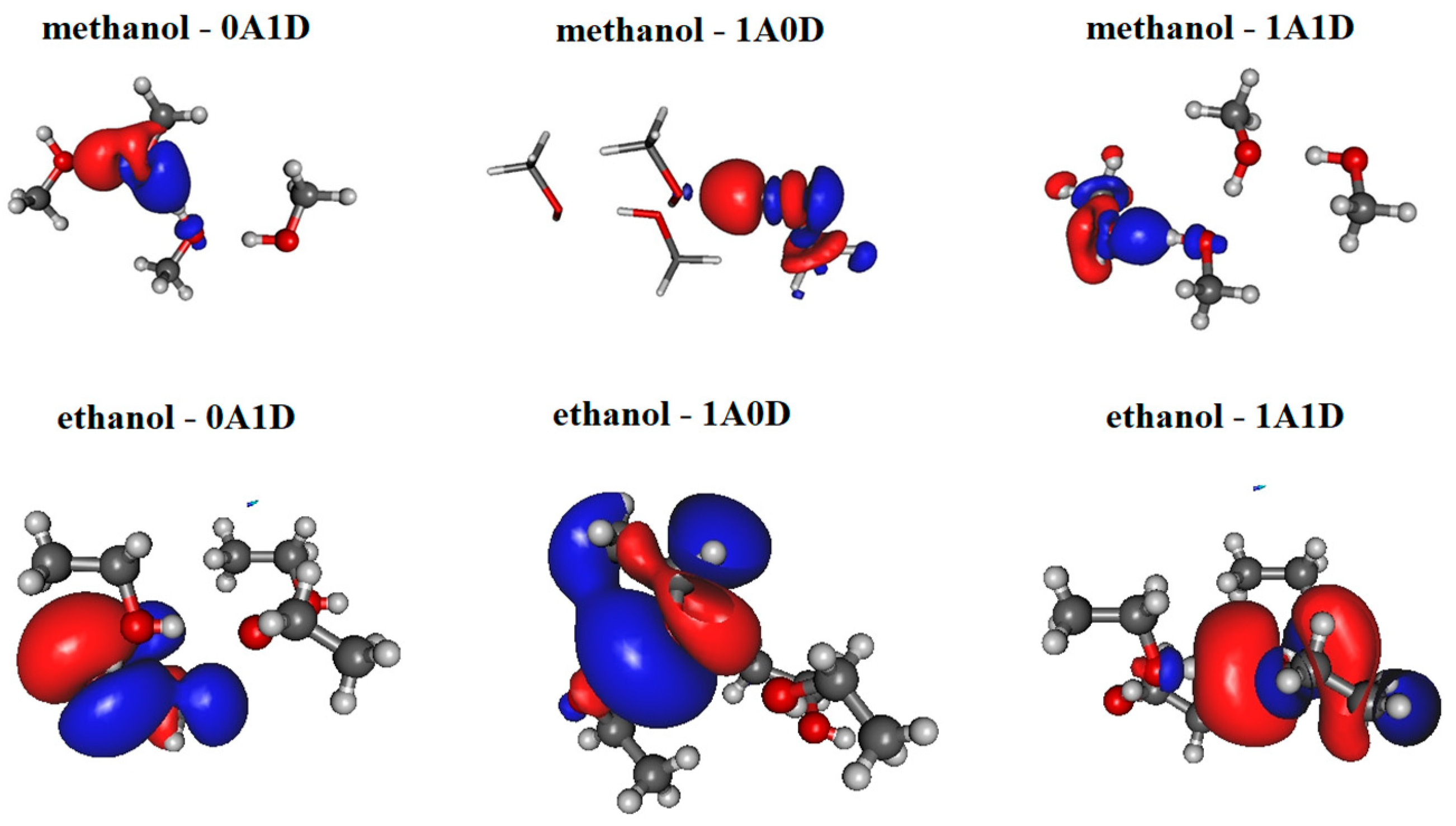
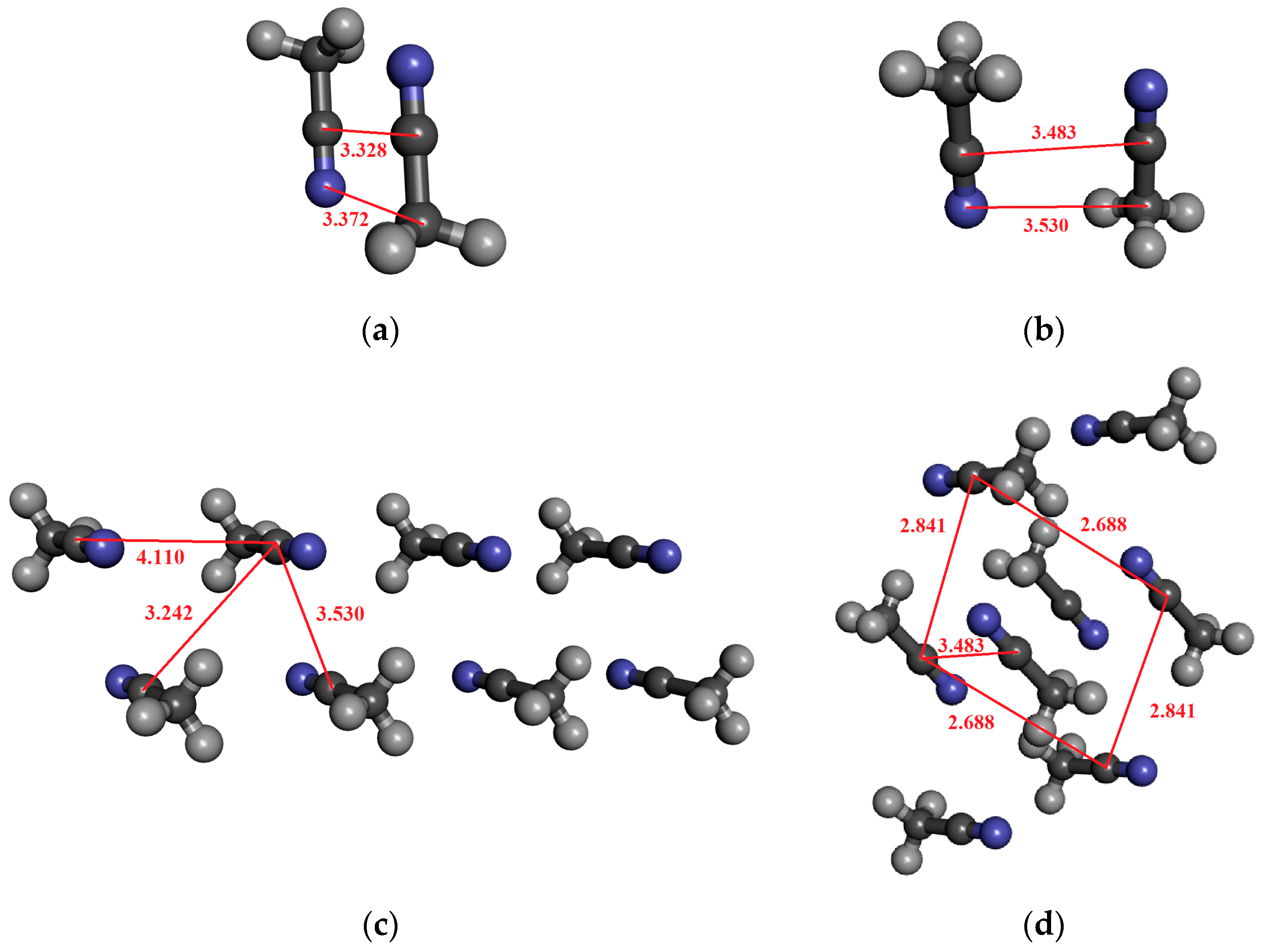
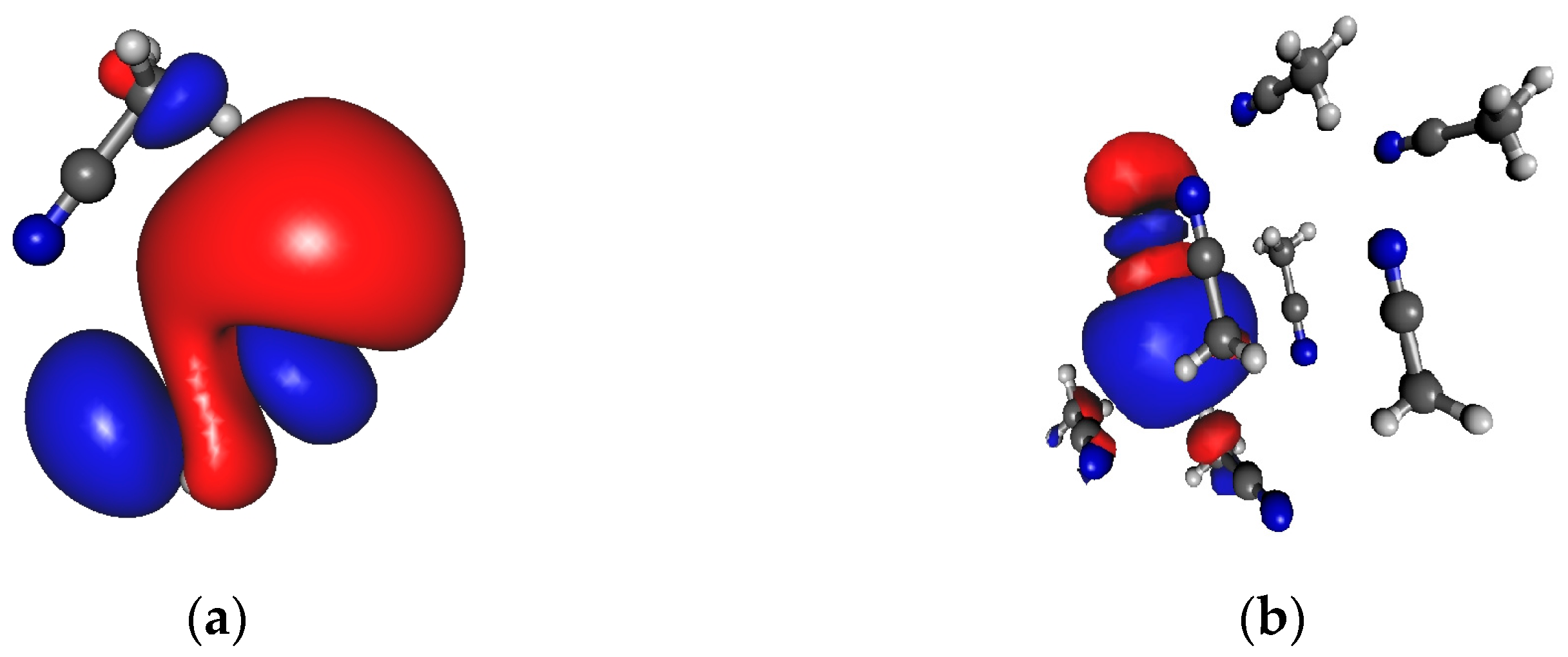

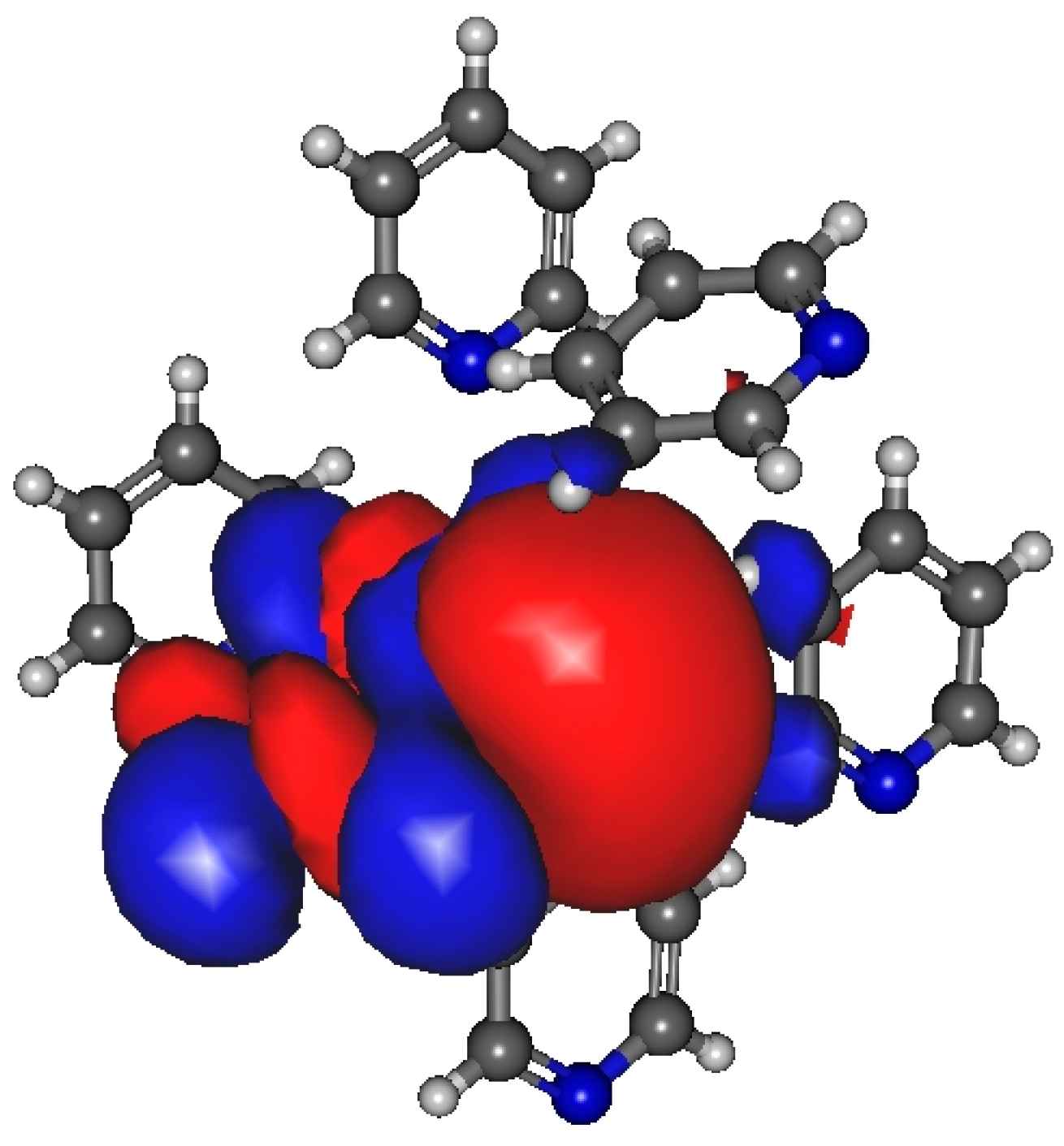


| Electronic Structure Methods | Systems | Monomer | PCM | SMD |
|---|---|---|---|---|
| M05-2X/cc-pVTZ | methanol | 1.718 | 2.024 | 2.237 |
| ethanol | 1.861 | 2.216 | 2.442 | |
| M06-2X/cc-pVTZ | methanol | 1.668 | 1.969 | 2.180 |
| ethanol | 1.808 | 2.156 | 2.379 | |
| ωB97XD/cc-pVTZ | methanol | 1.634 | 1.932 | 2.142 |
| ethanol | 1.777 | 2.124 | 2.348 | |
| M05-2X/AUG-cc-pVTZ | methanol | 1.735 | 2.090 | 2.311 |
| ethanol | 1.942 | 2.343 | 2.568 | |
| M06-2X/AUG-cc-pVTZ | methanol | 1.689 | 2.036 | 2.254 |
| ethanol | 1.891 | 2.283 | 2.504 | |
| ωB97XD/AUG-cc-pVTZ | methanol | 1.658 | 2.011 | 2.231 |
| ethanol | 1.868 | 2.266 | 2.489 | |
| CCSD/AUG-cc-pVTZ | methanol | 1.678 | 2.033 | 2.245 |
| ethanol | 1.986 | 2.274 | 2.491 | |
| CCSD(T)/AUG-cc-pVTZ | methanol | 1.682 | 2.029 | 2.251 |
| ethanol | 1.984 | 2.281 | 2.157 |
| Electronic Structure Methods | Monomer | PCM | SMD |
|---|---|---|---|
| M05-2X/cc-pVTZ | 4.095 | 4.954 | 5.107 |
| M06-2X/cc-pVTZ | 3.998 | 4.837 | 5.142 |
| ωB97XD/cc-pVTZ | 4.020 | 4.871 | 5.344 |
| M05-2X/AUG-cc-pVTZ | 4.158 | 5.064 | 5.107 |
| M06-2X/AUG-cc-pVTZ | 3.998 | 4.837 | 5.267 |
| ωB97XD/AUG-cc-pVTZ | 3.970 | 4.989 | 5.091 |
| CCSD/AUG-cc-pVTZ | 3.987 | 4.796 | 4.991 |
| CCSD(T)/AUG-cc-pVTZ | 3.918 | 4.721 | 4.912 |
| Number of Molecules | MP | MP_trunc |
|---|---|---|
| 2 (Figure 4a) | 4.56 | 4.51 |
| 2 (Figure 4b) | 3.96 | 3.94 |
| 4 | 4.40 ± 0.03 | 4.38 ± 0.02 |
| 8 (Figure 4c) | 4.39 ± 0.02 | 4.36 ± 0.02 |
| 8 (Figure 4d) | 4.67 ± 0.20 | 4.57 ± 0.21 |
| Electronic Structure Methods | Monomer | PCM | SMD |
|---|---|---|---|
| M05-2X/cc-pVTZ | 2.363 | 3.036 | 3.214 |
| M06-2X/cc-pVTZ | 2.290 | 2.943 | 3.117 |
| ωB97XD/cc-pVTZ | 2.322 | 2.992 | 3.169 |
| M05-2X/AUG-cc-pVTZ | 2.436 | 3.181 | 3.369 |
| M06-2X/AUG-cc-pVTZ | 2.363 | 3.083 | 3.267 |
| ωB97XD/AUG-cc-pVTZ | 2.405 | 3.155 | 3.345 |
| CCSD/AUG-cc-pVTZ | 2.423 | 3.175 | 3.368 |
| CCSD(T)/AUG-cc-pVTZ | 2.381 | 3.104 | 3.288 |
| Number of Molecules | MP | MP_trunc |
|---|---|---|
| 2 (Figure 6a) | 2.50 ± 0.01 | 2.49 ± 0.01 |
| 4 (Figure 6b) | 2.58 ± 0.20 | 2.53 ± 0.20 |
| 6 (Figure 6c) | 2.59 ± 0.10 | 2.50 ± 0.05 |
| 6 (Figure 6d) | 2.60 ± 0.11 | 2.55 ± 0.06 |
| Electronic Structure Methods | Monomer | PCM | SMD |
|---|---|---|---|
| M05-2X/cc-pVTZ | 3.153 | 3.881 | 3.877 |
| M06-2X/cc-pVTZ | 3.026 | 3.728 | 3.727 |
| ωB97XD/cc-pVTZ | 3.022 | 3.728 | 3.725 |
| M05-2X/AUG-cc-pVTZ | 3.270 | 4.072 | 4.074 |
| M06-2X/AUG-cc-pVTZ | 3.145 | 3.920 | 3.926 |
| ωB97XD/AUG-cc-pVTZ | 3.146 | 3.932 | 3.937 |
| iCCSD/AUG-cc-pVTZ | 2.978 | 3.723 | 3.723 |
| CCSD(T)/AUG-cc-pVTZ | 3.068 | 3.827 | 3.833 |
| Number of Molecules | MP | MP_trunc |
|---|---|---|
| 2 (Figure 8a) | 3.73 | 3.67 |
| 2 (Figure 8b) | 3.28, 3.04 | 3.27, 3.04 |
| 4 (Figure 8c) | 3.23 ± 0.14 | 3.19 ± 0.10 |
| 8 (Figure 8d) | 3.19 ± 0.18 | 3.12 ± 0.12 |
| Systems | Electrostatic Interaction | Exchange Interaction | Overlapping Interactions | Charge Transfer Term (MP) |
|---|---|---|---|---|
| Methanol | −45.1 | −15.7 | −14.4 | 0.06–0.07 |
| Ethanol (Figure 2a upper) | −30.1 | −7.5 | −10.5 | 0.035–0.04 |
| Acetonitrile | −7.1 | −2.3 | −2.9 | 0.016 |
| Pyridine | −6.3 | −1.3 | −3.1 | 0.02 |
| Acetone | −5.0 | −1.0 | −2.8 | 0.01 |
| Water cluster [22,23] | −40.1 | −24.0 | −20.1 | 0.08 |
| Number of Molecules | 0A1D (Chain-End) MP | 0A1D (Chain-End) MP_trunc | 1A0D (Chain-End) MP | 1A0D (Chain-End) MP_trunc | 1A1D (Inside) MP | 1A1D (Inside) MP_trunc |
|---|---|---|---|---|---|---|
| 2 | 1.82 | 1.84 | 2.14 | 1.92 | − | − |
| 4 | 2.02 | 2.02 | 2.38 | 2.05 | 2.48 ± 0.04 | 2.16 ± 0.02 |
| 8 | 2.05 | 2.05 | 2.41 | 2.08 | 2.60 ± 0.05 | 2.26 ± 0.03 |
| 10 | 2.06 | 2.05 | 2.42 | 2.08 | 2.63 ± 0.06 | 2.28 ± 0.03 |
| 12 | 2.06 | 2.06 | 2.42 | 2.08 | 2.65 ± 0.05 | 2.29 ± 0.04 |
| Number of Molecules | 0A1D (Chain-End) MP | 0A1D (Chain-End) MP_trunc | 1A0D (Chain-End) MP | 1A0D (Chain-End) MP_trunc | 1A1D (Inside) MP | 1A1D (Inside) MP_trunc |
|---|---|---|---|---|---|---|
| 2 (Figure 2a upper) | 1.81 | 1.79 | 2.05 | 1.88 | ||
| 2 (Figure 2a lower) | 1.79 | 1.76 | 2.04 | 1.82 | ||
| 4 | 1.97 | 1.81 | 1.990 | 1.94 | 2.11 ± 0.12 | 2.00 ± 0.02 |
| 8 | 2.06 | 1.83 | 2.15 | 1.96 | 2.30 ± 0.16 | 2.09 ± 0.10 |
| 10 | 2.01 | 1.83 | 2.16 | 1.97 | 2.32 ± 0.13 | 2.11 ± 0.10 |
| 12 | 2.01 | 1.83 | 2.16 | 1.97 | 2.34 ± 0.13 | 2.12 ± 0.10 |
Disclaimer/Publisher’s Note: The statements, opinions and data contained in all publications are solely those of the individual author(s) and contributor(s) and not of MDPI and/or the editor(s). MDPI and/or the editor(s) disclaim responsibility for any injury to people or property resulting from any ideas, methods, instructions or products referred to in the content. |
© 2025 by the authors. Licensee MDPI, Basel, Switzerland. This article is an open access article distributed under the terms and conditions of the Creative Commons Attribution (CC BY) license (https://creativecommons.org/licenses/by/4.0/).
Share and Cite
Bakó, I.; Pothoczki, S. Can We Unambiguously Define the Dipole Moment of Molecules in the Condensed Phase? Molecules 2025, 30, 1539. https://doi.org/10.3390/molecules30071539
Bakó I, Pothoczki S. Can We Unambiguously Define the Dipole Moment of Molecules in the Condensed Phase? Molecules. 2025; 30(7):1539. https://doi.org/10.3390/molecules30071539
Chicago/Turabian StyleBakó, Imre, and Szilvia Pothoczki. 2025. "Can We Unambiguously Define the Dipole Moment of Molecules in the Condensed Phase?" Molecules 30, no. 7: 1539. https://doi.org/10.3390/molecules30071539
APA StyleBakó, I., & Pothoczki, S. (2025). Can We Unambiguously Define the Dipole Moment of Molecules in the Condensed Phase? Molecules, 30(7), 1539. https://doi.org/10.3390/molecules30071539





